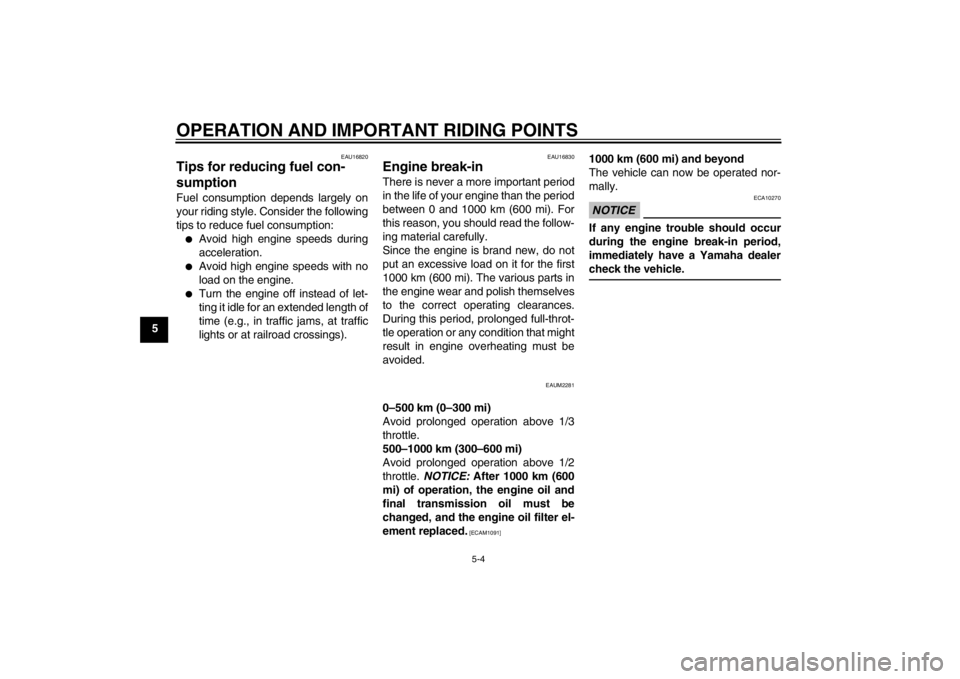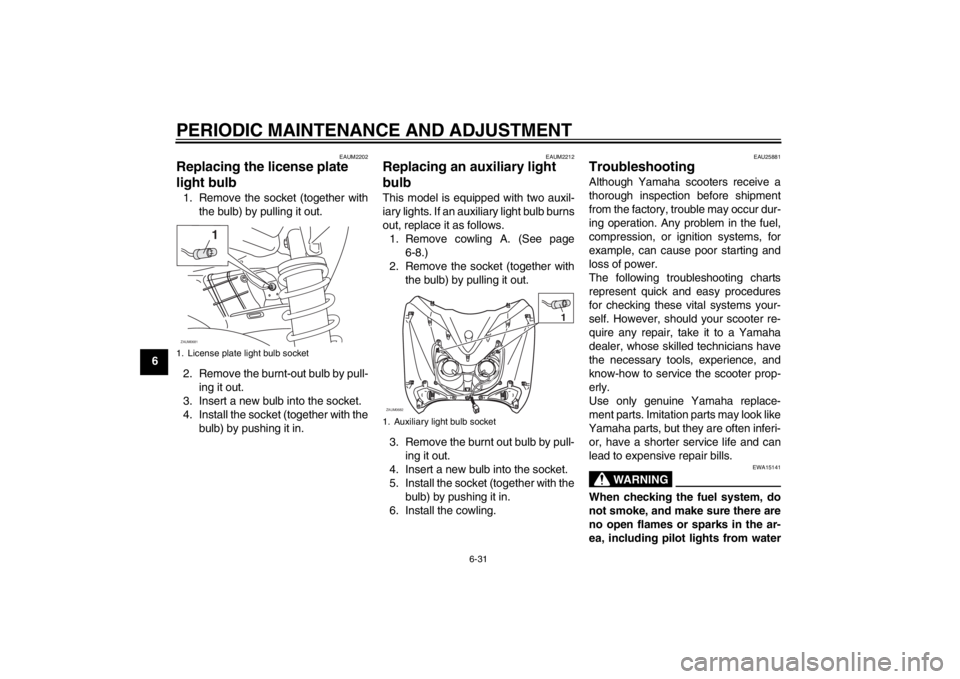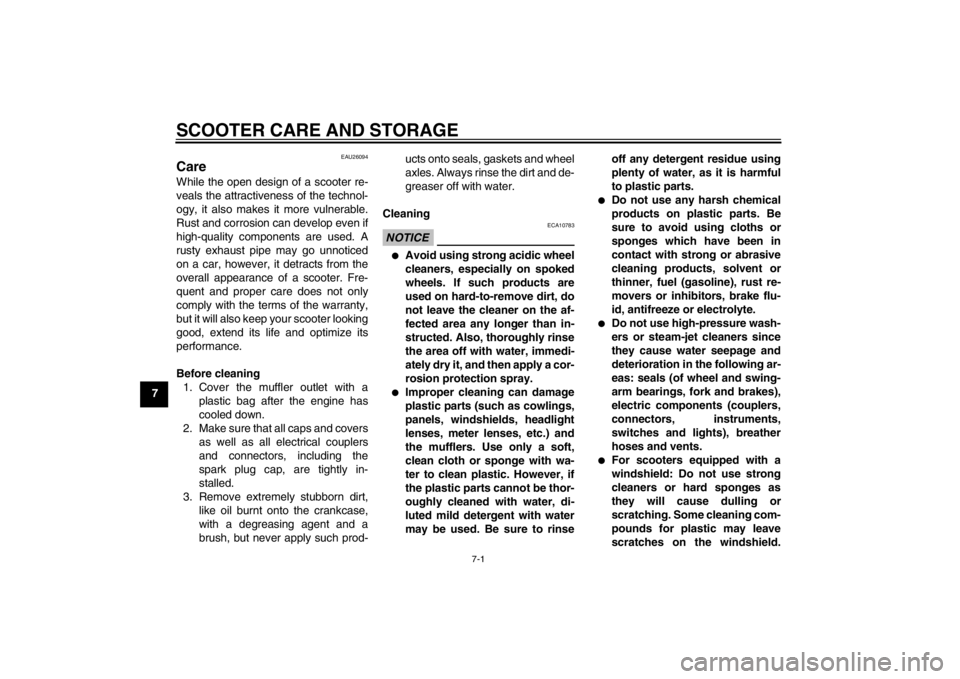2012 YAMAHA XCITY 125 lights
[x] Cancel search: lightsPage 40 of 86

OPERATION AND IMPORTANT RIDING POINTS
5-4
5
EAU16820
Tips for reducing fuel con-
sumption Fuel consumption depends largely on
your riding style. Consider the following
tips to reduce fuel consumption:●
Avoid high engine speeds during
acceleration.
●
Avoid high engine speeds with no
load on the engine.
●
Turn the engine off instead of let-
ting it idle for an extended length of
time (e.g., in traffic jams, at traffic
lights or at railroad crossings).
EAU16830
Engine break-in There is never a more important period
in the life of your engine than the period
between 0 and 1000 km (600 mi). For
this reason, you should read the follow-
ing material carefully.
Since the engine is brand new, do not
put an excessive load on it for the first
1000 km (600 mi). The various parts in
the engine wear and polish themselves
to the correct operating clearances.
During this period, prolonged full-throt-
tle operation or any condition that might
result in engine overheating must be
avoided.
EAUM2281
0–500 km (0–300 mi)
Avoid prolonged operation above 1/3
throttle.
500–1000 km (300–600 mi)
Avoid prolonged operation above 1/2
throttle. NOTICE: After 1000 km (600
mi) of operation, the engine oil and
final transmission oil must be
changed, and the engine oil filter el-
ement replaced.
[ECAM1091]
1000 km (600 mi) and beyond
The vehicle can now be operated nor-
mally.NOTICE
ECA10270
If any engine trouble should occur
during the engine break-in period,
immediately have a Yamaha dealer
check the vehicle.
U16PE3E0.book Page 4 Tuesday, June 19, 2012 5:17 PM
Page 47 of 86

PERIODIC MAINTENANCE AND ADJUSTMENT
6-6
6
EAU18670
TIP●
The air filter needs more frequent service if you are riding in unusually wet or dusty areas.
●
Hydraulic brake service
Regularly check and, if necessary, correct the brake fluid level.
Every two years replace the internal components of the brake master cylinders and calipers, and change the brake
fluid.
19*Cooling system Check coolant level and vehicle
for coolant leakage.√√√√√
Change coolant. Every 3 years
20Final transmission
oil Check vehicle for oil leakage.√√ √
Change.√√√
21*V- b e l t Replace. Every 18000 km (10500 mi)
22*Front and rear brake
switches Check operation.√√√√√√
23Moving parts and
cables Lubricate.√√√√√
24*Throttle grip Check operation.
Check throttle grip free play, and
adjust if necessary.
Lubricate cable and grip housing.√√√√√
25*Lights, signals and
switches Check operation.
Adjust headlight beam.√√√√√√ NO. ITEM CHECK OR MAINTENANCE JOBODOMETER READING
ANNUAL
CHECK 1000 km
(600 mi)6000 km
(3500 mi)12000 km
(7000 mi)18000 km
(10500 mi)24000 km
(14000 mi)
U16PE3E0.book Page 6 Tuesday, June 19, 2012 5:17 PM
Page 69 of 86

PERIODIC MAINTENANCE AND ADJUSTMENT
6-28
6
EAUM2182
Replacing a headlight bulb This model is equipped with halogen
bulb headlights. If a headlight bulb
burns out, replace it as follows.NOTICE
ECA10650
Take care not to damage the follow-
ing parts:●
Headlight bulb
Do not touch the glass part of
the headlight bulb to keep it free
from oil, otherwise the transpar-
ency of the glass, the luminosity
of the bulb, and the bulb life will
be adversely affected. Thor-
oughly clean off any dirt and fin-
gerprints on the headlight bulb
using a cloth moistened with al-
cohol or thinner.
●
Headlight lens
Do not affix any type of tinted
film or stickers to the headlight
lens.
Do not use a headlight bulb of a
wattage higher than specified.
To replace a high beam headlight
bulb
1. Remove cowling A. (See page
6-8.)
2. Remove the headlight bulb cover.3. Unhook the headlight bulb holder
by turning it counterclockwise, and
then remove the burnt out bulb.
4. Place a new headlight bulb into po-
sition, and then secure it with the
bulb holder by turning it clockwise.
5. Install the headlight bulb cover.
6. Install the cowling.
7. Have a Yamaha dealer adjust the
headlight beam if necessary.
To replace a low beam headlight
bulb
1. Remove cowling A. (See page
6-8.)
2. Remove the headlight bulb cover.1. Do not touch the glass part of the bulb.
1. Headlight bulb cover
1
ZAUM0674
1. Headlight bulb holderZAUM0675
1
U16PE3E0.book Page 28 Tuesday, June 19, 2012 5:17 PM
Page 72 of 86

PERIODIC MAINTENANCE AND ADJUSTMENT
6-31
6
EAUM2202
Replacing the license plate
light bulb 1. Remove the socket (together with
the bulb) by pulling it out.
2. Remove the burnt-out bulb by pull-
ing it out.
3. Insert a new bulb into the socket.
4. Install the socket (together with the
bulb) by pushing it in.
EAUM2212
Replacing an auxiliary light
bulb This model is equipped with two auxil-
iary lights. If an auxiliary light bulb burns
out, replace it as follows.
1. Remove cowling A. (See page
6-8.)
2. Remove the socket (together with
the bulb) by pulling it out.
3. Remove the burnt out bulb by pull-
ing it out.
4. Insert a new bulb into the socket.
5. Install the socket (together with the
bulb) by pushing it in.
6. Install the cowling.
EAU25881
Troubleshooting Although Yamaha scooters receive a
thorough inspection before shipment
from the factory, trouble may occur dur-
ing operation. Any problem in the fuel,
compression, or ignition systems, for
example, can cause poor starting and
loss of power.
The following troubleshooting charts
represent quick and easy procedures
for checking these vital systems your-
self. However, should your scooter re-
quire any repair, take it to a Yamaha
dealer, whose skilled technicians have
the necessary tools, experience, and
know-how to service the scooter prop-
erly.
Use only genuine Yamaha replace-
ment parts. Imitation parts may look like
Yamaha parts, but they are often inferi-
or, have a shorter service life and can
lead to expensive repair bills.
WARNING
EWA15141
When checking the fuel system, do
not smoke, and make sure there are
no open flames or sparks in the ar-
ea, including pilot lights from water
1. License plate light bulb socketZAUM0681
1
1. Auxiliary light bulb socketZAUM0682
1
U16PE3E0.book Page 31 Tuesday, June 19, 2012 5:17 PM
Page 76 of 86

SCOOTER CARE AND STORAGE
7-1
7
EAU26094
Care While the open design of a scooter re-
veals the attractiveness of the technol-
ogy, it also makes it more vulnerable.
Rust and corrosion can develop even if
high-quality components are used. A
rusty exhaust pipe may go unnoticed
on a car, however, it detracts from the
overall appearance of a scooter. Fre-
quent and proper care does not only
comply with the terms of the warranty,
but it will also keep your scooter looking
good, extend its life and optimize its
performance.
Before cleaning
1. Cover the muffler outlet with a
plastic bag after the engine has
cooled down.
2. Make sure that all caps and covers
as well as all electrical couplers
and connectors, including the
spark plug cap, are tightly in-
stalled.
3. Remove extremely stubborn dirt,
like oil burnt onto the crankcase,
with a degreasing agent and a
brush, but never apply such prod-ucts onto seals, gaskets and wheel
axles. Always rinse the dirt and de-
greaser off with water.
Cleaning
NOTICE
ECA10783
●
Avoid using strong acidic wheel
cleaners, especially on spoked
wheels. If such products are
used on hard-to-remove dirt, do
not leave the cleaner on the af-
fected area any longer than in-
structed. Also, thoroughly rinse
the area off with water, immedi-
ately dry it, and then apply a cor-
rosion protection spray.
●
Improper cleaning can damage
plastic parts (such as cowlings,
panels, windshields, headlight
lenses, meter lenses, etc.) and
the mufflers. Use only a soft,
clean cloth or sponge with wa-
ter to clean plastic. However, if
the plastic parts cannot be thor-
oughly cleaned with water, di-
luted mild detergent with water
may be used. Be sure to rinseoff any detergent residue using
plenty of water, as it is harmful
to plastic parts.
●
Do not use any harsh chemical
products on plastic parts. Be
sure to avoid using cloths or
sponges which have been in
contact with strong or abrasive
cleaning products, solvent or
thinner, fuel (gasoline), rust re-
movers or inhibitors, brake flu-
id, antifreeze or electrolyte.
●
Do not use high-pressure wash-
ers or steam-jet cleaners since
they cause water seepage and
deterioration in the following ar-
eas: seals (of wheel and swing-
arm bearings, fork and brakes),
electric components (couplers,
connectors, instruments,
switches and lights), breather
hoses and vents.
●
For scooters equipped with a
windshield: Do not use strong
cleaners or hard sponges as
they will cause dulling or
scratching. Some cleaning com-
pounds for plastic may leave
scratches on the windshield.
U16PE3E0.book Page 1 Tuesday, June 19, 2012 5:17 PM
Page 84 of 86

INDEXAAcceleration and deceleration................. 5-3
Air filter and V-belt case air filter
elements ............................................. 6-15
Auxiliary light bulb, replacing ................ 6-31BBattery................................................... 6-25
Brake fluid, changing ............................ 6-22
Brake fluid level, checking .................... 6-21
Brake lever, front..................................... 3-9
Brake lever, rear ..................................... 3-9
Brake levers, lubricating........................ 6-23
Braking .................................................... 5-3CCables, checking and lubricating .......... 6-22
Care ........................................................ 7-1
Carrier ................................................... 3-16
Catalytic converters .............................. 3-12
Centerstand and sidestand, checking
and lubricating .................................... 6-23
Coolant.................................................. 6-14
Coolant temperature gauge .................... 3-5
Cowlings and panels, removing and
installing................................................ 6-8DDimmer switch ........................................ 3-9
Display, multi-function ............................. 3-5EEngine break-in ....................................... 5-4
Engine oil .............................................. 6-10
Engine trouble warning light.................... 3-3FFinal transmission oil ............................ 6-13
Front and rear brake lever free play...... 6-19Front and rear brake pads, checking .... 6-20
Front fork, checking .............................. 6-24
Fuel....................................................... 3-10
Fuel consumption, tips for reducing........ 5-4
Fuel gauge.............................................. 3-5
Fuel tank cap ........................................ 3-10
Fuses, replacing ................................... 6-27
HHandlebar switches ................................ 3-8
Headlight bulb, replacing ...................... 6-28
High beam indicator light ........................ 3-3
Horn switch ............................................. 3-9IIdentification numbers ............................ 9-1
Ignition circuit cut-off system ................ 3-17
Immobilizer system ................................. 3-1
Immobilizer system indicator light........... 3-3
Indicator lights and warning light ............ 3-3LLicense plate light bulb, replacing ........ 6-31
Luggage hook ....................................... 3-16MMain switch/steering lock........................ 3-2
Maintenance and lubrication, periodic .... 6-4
Maintenance, emission control system... 6-3
Model label ............................................. 9-1PParking ................................................... 5-5
Part locations .......................................... 2-1SSafe-riding points.................................... 1-5
Safety information................................... 1-1
Seat ...................................................... 3-12Shock absorber assemblies,
adjusting ............................................. 3-15
Sidestand .............................................. 3-16
Spark plug, checking ............................... 6-9
Specifications .......................................... 8-1
Speedometer........................................... 3-4
Starting off ............................................... 5-2
Starting the engine .................................. 5-1
Start switch.............................................. 3-9
Steering, checking................................. 6-25
Storage.................................................... 7-3
Storage compartments .......................... 3-13
TTail/brake light bulb or rear turn signal
light bulb, replacing ............................. 6-30
Throttle grip and cable, checking and
lubricating ........................................... 6-23
Throttle grip free play, checking ............ 6-16
Tires ...................................................... 6-17
Tool kit..................................................... 6-2
Troubleshooting .................................... 6-31
Troubleshooting charts.......................... 6-33
Turn signal indicator light ........................ 3-3
Turn signal light bulb (front),
replacing ............................................. 6-29
Turn signal switch ................................... 3-9VValve clearance..................................... 6-17
Vehicle identification number .................. 9-1WWheel bearings, checking ..................... 6-25
Wheels .................................................. 6-19
Windshield............................................. 3-14
U16PE3E0.book Page 1 Tuesday, June 19, 2012 5:17 PM